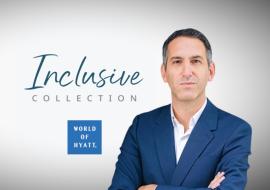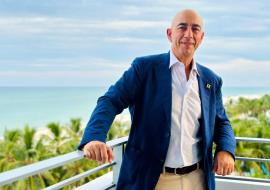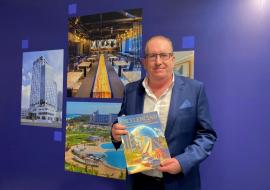Q & A with Thomas Meller, Director of Development and Operations, MesoAmerican Reef Tourism Initiative (MARTI)

Q & A with Thomas Meller
Director of Development and Operations, MesoAmerican Reef Tourism Initiative (MARTI)
By Jose Carlos de Santiago
After four decades practically unpopulated, Cancun-Riviera Maya tourism corridor presently counts on over 70.000 hotel rooms and welcomes some ten million tourists a year, while Cozumel’s cruiser port is ranked second worldwide. The Mesoamerican Reef stretches for over 700 Km in front of the coasts of Quintana Roo and all the way down to Honduras, it’s the second largest in the world and is a huge ecological reservoir. MARTI project tries to lead the hotel growth through environment-friendly ways, so the region maintains its main asset: natural wealthy.
Tell me about this twelfth Conference of Sustainable Tourism in the Caribbean (STC-12)
I was invited to talk about the MesoAmerican Reef Tourism Initiative (MARTI), which includes several partners and allies to achieve the implementation of sustainable practices in some sector of tourism industry. MARTI started back in October 2006, boosted by three founding partners: Conservation International, based in Washington; Coral Reef Alliance, a NGO based in San Francisco, California, and Amigos de Sian Ka’an, third funder organization, an NGO that supports environmental projects in Quintana Roo. I work with this organization.
We began working several action lines, mainly with the hotel sector, supporting it on the introduction of positive environmental practices through the establishment of environmental management systems. We also work with developers, architects and investors so the next hotels, resorts and other facilities can be built by thinking green, using tools such as bioclimatic architecture and a more sustainable project planning. Likewise, other matters were included, such as the search of more security in our region for investors and their investment.
Our partners deal with other issues, such Coral Reef Alliance with underwater services, companies operating boats and offering scuba and snorkel tours; also trying to implement environmental practices in those operations. There is other action line which includes cruiser companies. Cozumel, as it’s pretty well known, is the largest cruiser port in the world, after Miami: 2.5 million tourists arrive in every year. We work with an inter-sectorial group, including business men from Cozumel, to decrease the environmental impact of this sector. We want them to incorporate in their work and business what we call Destination Stewardship, in the cruiser industry.
We are not and we don’t want to be the authority. Our way is voluntary nature and association, joint work with actors from the touristic sector.
What do you think that could be improved in this conference on sustainable touristic development, organized by CTO?
First of all, the CTO and organizers must be congratulated. The conference has reached its twelfth edition and is held year after year. The Caribbean is very diverse: many islands, many cultures, several languages, but the essence of challenges faced by the travel industry is quite similar, in spite of nuances among countries. Therefore, I think that counting on a forum where you can exchange experiences and concepts in the field of sustainability, learn from those experiences and even copy projects, is remarkably important. If I were to point out something perfectible in STC Conference, I would aim at the necessity of more decision makers to attend these events, so as to get a truly effective commitment. CTO’s member states must be committed to bring their key elements, their tourism ministers or directors, the people who can return to their countries with these ideas and the willpower to implement them.
What can be done to effectively commit the governments in these sustainable tourism initiatives?
Well, we face the challenge in our own project, and it’s bringing into the initiative every institution, representatives of the government and private sector; gathering all of them on the same boat so we can all row in the same direction. It’s very hard. And our experience is based on one country, so if we look at the Caribbean as a region, all the islands and their diversity, the challenge seems to be bigger. I understand that more countries have attended STC conferences in previous editions. A steady attendance must be guaranteed, a commitment. Every country should participate with, at least, two decision makers in this field of tourism and sustainability. Perhaps it shouldn’t be held every year, but every other year, so there is no agenda or budget problem for those who didn’t attend now.
Some excessive urban developments in Mexico, particularly in Riviera Maya, in the middle of the Mexican Caribbean, have cost a lot in terms of environment. What measures are the federal government and state and local governments taking to improve the infrastructure in an environmental way?
The region we’re working in, the north of Quintana Roo, has had a tremendous hotel and infrastructure growth. There were moments during this year when Playa del Carmen was the site with the highest rate of growth in percentage terms in Latin America. Sometimes, for instance, the boosting-project private sector is faster than the infrastructure public sector. A tremendous work has been carried out in our area in terms of infrastructure, drinkable water supply, drainage and water treatment; and it’s all related to the accelerated development of hotel and catering business.
We’re the only Mexican state with most of its coast regularized through plans of local and ecological organization (POEL). The state counts on soil use planning, preservation, though it might not be enough to regulate the development in a less impacting way. A significant progress has been made: for example, we currently have, by law, a total protection of mangrove swamp, though there are some application gaps, and many projects have been redesigned to adapt their efforts to the ecosystem protection. It’s an ongoing work, as the plans of tourism growth are very ambitious in Mexico. I think that the environmental awareness has grown up in recent years, in the governmental, business and citizen levels.
Does your organization count on private or public budget?
We started with philanthropic funds, given by foundations and other institutions, trying to develop our non profitable project. However, we’re looking for a more significant contribution from the private sector. For example, MARTI presently includes 120 hotels which count on over 32 thousand rooms, 40 or 45% of the state’s hotel infrastructure. These hotels pay a symbolic fee, some annual 1.000 dollars. It’s a beginning. We’re also diversifying our sponsors, looking for funds from other institutions and increasing the contribution from the private sector.
Is there any hotel group showing particular awareness related to this issue?
There’s a lot of Spanish investment in Riviera Maya and we’ve found many doors opened in these business, but not all of them. We think that Riviera Maya and Cancun have different markets. Catalonia, H10 Hotels and Fiesta Hotel Group are some of the best groups. Meliá has been very active, with some of its properties participating in the Green Globe program, just before MARTI appearance. Iberostar, Iberostar Cozumel and other properties have worked with us, but we still have to move forward. There are other groups and companies with corporative programs, such as IHG or Marriott.
We began in Riviera Maya and we’re currently entering Cancun, where you find more companies. We need to widen our work with these groups, but we’re already actively working with AM Resorts; Palace Resorts is also a member of MARTI, we’re working with them in a campaign of guest awareness, which have been developed with Travel Foundation Holland, and we want to explore the possibility of establishing a protected natural area within one of their properties.
What’s MARTI’s goal for the next three years?
We are focused in the Mesoamerican reef region. As first goal, we want hotels in Quintana Roo, the Mexican Caribbean, to implement green practices, which are presently applied in some facilities; we want most of hotels to be built applying techniques of environmental planning, design and construction, from the location of buildings and bioclimatic architecture to the minimum environmental impact during the construction process and after the operation, and we wish to stretch our operations to the south, as the reef goes down to Belize, Guatemala (with no important touristic development in the coast) and Honduras… We want to multiply our experiences in those destinations. We already have activities in Roatan. I told you about the work carried out with cruise lines in Cozumel, and that’s something we want reactivate in Roatan. Likewise, Belize is an important cruise port.
We also want to increase the contribution of private sector in these programs, and widen the work with tour operators, which are very important for hotel chains as they provide an environmental character for hotels. There are tour operators such as TUI and Kuoni or Travelife, that have environmental programs to classify the hotels they work with, and we have the Travelife Sustainability System in the United Kingdom, so British tour operators classify hotels from all over the world. We also have ties with Canadian Transat. Nevertheless, we have to work harder with American tour operators.














